Abstract
Public parking spaces are facilities that support the activities of urban residents with relatively high mobility. As with all definitions of public spaces, public parking space facilities are assumed to be accessible to everyone without questioning their status. Several different things are found in public parking spaces in higher education institutions at UNHAS. This research examines the meaning of public parking spaces for UNHAS people and how they are connected to these facilities. The study was conducted at the Tamalanrea UNHAS campus. Data were collected using in-depth interviews to explore how they perceive zoning meanings, accessibility of public parking spaces, the signages placed there, and observations surrounding campus parking spaces. The interview involved 140 informants consisting of structural officials, lecturers, employees, students, and guests. The results showed that, in practice, the public parking space of UNHAS had become a private space because it cannot be accessed and used freely by everyone, except those with specific social status as written on parking signs (i.e., rector, vice-rector). It is also found that parking spaces have become an etalage for displaying and promoting the personal social status of UNHAS officials.References
Arendt, H. (1958). The Human Condition. Chicago: The University of Chicago.
Ashton, P.; Doussard, M.; and Weber, R. (2012). “The Financial Engineering of Infrastructure Privatization What Are Public Assets Worth to Private Investors?”, Journal of the American Planning Association, 78 (3): 300-312.
Auchincloss, A. H.; Weinberger, R.; Aytur, S., Namba, A.; and Ricchezza, A. (2015). “Public Parking Fees and Fines: A Survey of U.S. Cities”, Public Works Management & Policy, 20 (1): 49-59.
Bone, M. N. (2020, April 3). Sering Beraksi di Kampus Unhas Makassar, Maling Spesialis Cungkil Jok Motor Digerebek Polisi, Retrieved Juli 2, 2020, from iNewsSulsel.id: https://sulsel.inews.id/berita/sering-beraksi-di-kampus-unhas-makassar-maling-spesialis-cungkil-jok-motor-digerebek-polisi, accessed July2, 2020.
Direktorat Jenderal Perhubungan Darat. (1996). Keputusan Direktur Jenderal Perhubungan Darat Nomor : 272/Hk.105/Drjd/96 Tentang Pedoman Teknis Penyelengaraan Fasilitas Parkir. Jakarta: Direktorat Jenderal Perhubungan Darat. . Jakarta: Direktorat Jenderal Perhubungan Darat.
Geertz, C. (2013). “Religion as a Cultural System”, in M. Banton (ed.), Anthropological Approaches to the Study of Religion. London: Routledge, pp. 1-46.
Gofmann, E. (1971). Relation in Public. New York: Basic Books, Inc. Publisher.
Green, W. R. (2011). The Retail Store - Design and Construction (2nd edition). San Jose: iUniverse.com, Inc.
Habermas, J. (1991). The Structural Transformation of The Public Space, An Inquiry into A Category Of Bourgeois Society. Cambridge: MIT Press.
Identitas. (2019). Satpam Unhas Bekuk Dua Pelaku Pencuri Motor. https://identitasunhas.com/satpam-unhas-bekuk-dua-pelaku-pencuri-motor/, accessed on July 2, 2020
Khalili, A. M. (2017). “Creativity in Store Design - A Study on the Influential Role of Store Design and Storefront Design in a Relationship with Urban Perception to Present a Brand”, Architecture Research, 7 (3):92-17.
Koops, B. J., and Galič, M. (2017). “Conceptualising Space and Place: Lessons from Geography for the Debate on Privacy in Public”, in Timan, T; Newell, C. C.; and Koops, B. J. (eds.), Privacy in Public Space: Conceptual and Regulatory Challenges. Cheltenham: Edward Elgar Publishing, pp. 19-46.
Langgut-Terre, E. (2011). Manusia Politis Menurut Hannah Arendt – Pertautan antara Tindakan dan Ruang Publik, Kebebasan dan Pluralitas, dan Upaya Memanusiakan Kekuasaan. Jakarta: Komunitas Salihara.
Martosenjoyo, T.; Naping, H.; Rahim, M. R.; and Lampe, M. (2020). “Public Toilets, Stink, and Power”, The Asia Pacific Journal of Anthropology, 21(3): 229-247.
Nasution, A. D., & Zahrah, W. (2012). Public Open Space Privatization and Quality of Life, Case Study Merdeka Square Medan. In M. Y. Abbas, M. Y.; Bajunid, A. F.; and Azhari, N. F. (eds.), ASEAN Conference on Environment-Behaviour Studies, The Other Space: Policy, Culture and Human Behaviour. 36, pp. 466-475. Amsterdam: Elsevier, pp. 466-475.
Neal, Z. P. (2010). “Locating Public Space”, in A. M. Orum, A. M. and Z. P. Neal, Z. P. (eds), Common Ground? Readings and Reflections on Public Space. New York: Routledge: Taylor and Francis, pp. 1-12.
Pachenkov, O., & Voronkova, L. L. (2013). “Urban Public Space In The Context of Mobility and Aestheticization: Setting The Problem Institute for European Ethnology”, in Pachenkov, O. (ed.), Workshop Introductory Speech: Urban Public Space In The Context Of Mobility And Aestheticization: Facing Contemporary Challenges, Frankfurt: Peter Lang GmbH, pp. 13-30.
Pelras, C. (2006). Manusia Bugis. Jakarta: Nalar, Forum Jakarta-Paris.
Sennett, R. (2010). “The Public Realm”, in Bridge, G. and Watson, S. (eds.), The Blackwell City Reader. (pp. 261-272). London: Blackwell Publishers, pp. 261-272.
Smith, M. S. (2002). “Signage”, in Chrest, A. P.; Smith, M. S. Buyan, A.; Monahan, D. R.; and Iqbal, M. (eds.), Parking Structure - Planning, Desgn, Construction, Maintenance, Repair. Boston: Kluwer Academic Punlishers, pp. 333-398.
Syukur. (2017). Dua Pencuri Motor di Unhas Tertangkap Basah, http://news.rakyatku.com/read/52271/2017/06/10/dua-pencuri-motor-di-unhas-tertangkap-basah, accessed on July 2, 2020.
The Free Dictionary. (2020). Storefront, https://www.thefreedictionary.com/storefront, accessed on July 6, 2020.
Tilley, C. (1994). A Phenomenology of Landscape Places, Paths and Monuments. Oxford, Providence: Berg.
United Nations Educational, Scientific and Cultural Organization. (2017). Inclusion Through Access to Public Space Definition, http://www.unesco.org/new/en/social-and-human-sciences/themes/urban-development/migrants-inclusion-in-cities/good-practices/inclusion-through-access-to-public-space/, accessed on July 11, 2020.
Wikipedia. (2020). Etalase, https://id.wikipedia.org/wiki/Etalase, accessed on June 20, 2020.

This work is licensed under a Creative Commons Attribution-NonCommercial 4.0 International License.
Copyright (c) 2020 ETNOSIA : Jurnal Etnografi Indonesia





